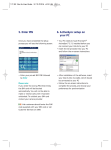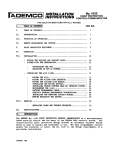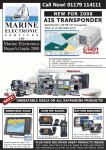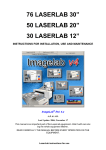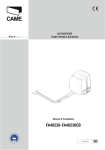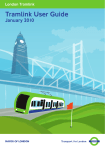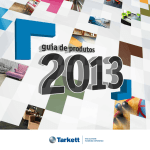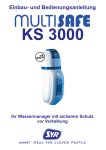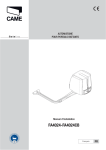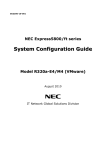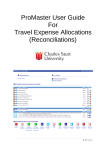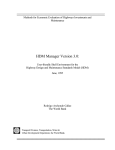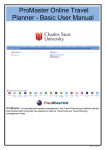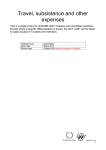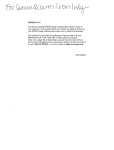Download Book 5 Ticket office operations Ticketing & Revenue
Transcript
Transport for London London Underground Network Services Book 5 Ticket office operations Ticketing & Revenue Issue 9 MAYOR OF LONDON Ticket office operations Contents Section Page 1 General section 2 2 Customer payments - cash 11 3 Customer payments - bank cards 17 4 Customer payments - cheques 24 5Customer payments - warrants and vouchers 29 6 Other payments 39 7 Receipt for tickets sold 46 8 Interruption of train service 47 9 Checking ticket details 49 10 Assistance window 51 11 Emergency cash advance 63 12 Equipment failure 65 13 Equipment maintenance 70 14 ROLT/RLMP forms 71 section 1 General section 1 General section 1.1 Individual accountability You must always: • keep money and other receipts secure and never leave unattended • keep money and other items secured in a cash drawer until deposited in the safe • keep notes and coins in separate denominations within the drawer • keep the amount of money in your cash drawer to a minimum, preparing and depositing a Counted bag where necessary • secure the TOM or sign off before leaving the TOM unattended • keep your personal possessions out of view of customers. You must never: • use a TOM/POM that you are not signed on to • disclose your PIN to anyone. 1.2 Ticket Office Log Book The TOLB acts as an audit record of events in the ticket office. A new TOLB must be started on the first day of each month. 2 1 section General section The TOLB is used to record: Activity Requirement Staff undertaking ticket office duties You must sign and record the time whenever you enter or leave the ticket office. Visitors to the ticket office You must make sure that all visitors sign and record the time whenever they enter and leave the ticket office. Movement of keys All movement of ticket office keys and the seal number used to secure the float safe key must be recorded. Events You must record NOC messages and other events affecting the operation of the ticket office or where a safe audit or deposit has been witnessed by a member of staff without a TSID card. Supervisory checks A space is provided for the station supervisor to sign to confirm that supervisory ticketing checks have been carried out each day. Safe checks You must record details of checks to confirm safes are secure. 3 section 1 1.3 General section Ticket Seller ID Card (TSID) TSID cards are only issued to qualified ticket sellers. You must make sure that your TSID card is: • used only by you • available whenever you are on duty • kept secure and your PIN is not disclosed to any other person. On the first occasion that you use your TSID card at a ticket office, you must input a user name, which must be your first name followed by your surname/family name. If your TSID card is replaced, you must add the number ‘1’ or ‘2’ (as appropriate) after your name when the replacement card is first used. Ticket office Coaches are issued with two TSID cards – a special Coach’s card for their use and a second card for use by their trainee. If you are using your Coach’s card for the first time, you must enter your first name followed by your surname/family name, followed by ‘Coach’. For the trainee’s card, you must enter ‘Trainee’ after your surname/family name. When signing on to a TOM using your Coach’s card, you must select ‘Ticket Seller’ mode for normal use or ‘Coach’ mode if you have a trainee. The ‘Coach’ option will prompt you for a second TSID card to be swiped, which can be the trainee’s own card or the second card held by you. 4 1.4 1 section General section Emergency TSID card At each station with an operational ticket office, an emergency TSID card and associated PIN are contained within a sealed envelope in a multi-safe bag inside the float safe. Where there is more than one ticket office on the station, only one emergency TSID card is required. You must make sure the multi-safe bag is recorded on the SAF and checked whenever an audit of the float safe is undertaken. Before you can use an emergency TSID card, you must contact the duty station manager and give the following details: • your name, employee number and Staff Oyster card number • your home station • the reason for the use of the emergency TSID card • the multi-safe bag number. You must not open the emergency TSID card bag until you have received authorisation from the duty station manager. When you have received authorisation to use the TSID card, it will become your responsibility as soon as the envelope within the multisafe bag is opened. You must: • record the details in the TOLB • complete a Record of Issue of Emergency TSID card form • complete a Replacement of Emergency ‘Ticket Seller’ ID card form • send both forms to the group station manager as soon as possible • update your SAF user name. 5 section 1 1.5 General section Storage and retention of documents The following items must be retained for the periods shown below: 1.6 Item Retention Period Emergency Safe Contents Register 12 Months (after last entry) Maintenance and Failure Register 12 Months (after last entry) MOVie Device Register 3 Months (after last entry) Key Seal Register 3 Months (after last entry) Ticket Office Log Book 36 Months (first 12 months within the ticket office and a further 24 months archived) Station supervisor daily check 4 Weeks Ticket stock and photocards The following items are supplied automatically by CTS based on previous usage: • Oyster cards • record cards • Oyster registration forms • ticket rolls (other than for QBM) • pre-cut stock • season ticket wallets. An extra allowance of wallets is given to stations with high numbers of tourists. If supplies of stock fall below two weeks supply, or if an emergency delivery is required, you must contact the CTS Help Desk. 6 1 section General section When requesting an emergency delivery or to stop further deliveries of an item, you must fill in a Prestige consumables ‘Ticket Stock Reconciliation’ form detailing current stocks of each item and fax this to CTS. You can order the following items from CTS: Item Quantity supplied How to order Adult photocard Male or Female, Prestige consumables on-line order form Pack of 10 TOM receipt rolls Pack of 20 QBM receipt rolls Pack of 12 QBM ticket rolls Box of 6 TOM receipt printer cartridge Individually If any ticket stock or wallets are transferred between stations, you must tell the CTS Help Desk so that accurate stock records can be maintained. Ribbons and paper for the ticket office printer must be ordered from the LU stationery supplier via SAP. 1.7 Ticket office deliveries When there is a delivery by CTS, you must: • check the delivery is for the correct station • check details of the stock received against the delivery note • sign all copies of the delivery note, endorsing it with your employee number and station stamp • retain the top copy of the delivery note at the station • place the copy of the delivery note in the freepost envelope provided and post to CTS. 7 section 1 General section If boxes have been opened or items are damaged or missing, you must not accept the delivery and must make sure the CTS Help Desk is told immediately. After delivery, you must make sure all items are stored in a secure location within a steel cupboard or storage bin. 1.8 Lost Property A station supervisor might require an item of value to be secured in a safe until it is collected. Before an item of lost property is placed within the safe, you must create a Lost Property bag. Record details on the multi-safe bag: Creating a lost property bag •• name •• station •• date •• TSID •• contents Select bag operations and ‘Create Other Bag’ on the SAF Scan the bag to be used Select ‘Lost Property’ and record actual bag contents Specify the contents of the bag on the SAF Seal the item in the bag Commit Assign to yourself and keep secure until ready to deposit Enter the details in the TOLB 8 1 section General section Removing a lost property bag Select ‘Safe Operations’ and the relevant safe Undertake a safe audit Select ‘Remove Bag’ Scan bag to be removed from the safe Commit Witness to confirm Select •• SAF operations •• Administration •• Remove item from station Scan the bag Select ‘Transferred to station supervisor’ Commit Enter the details in the TOLB and get the station supervisor to sign to acknowledge receipt of lost property 9 section 1 1.9 General section F ound Season tickets, Oyster cards and staff travel documents If the following items are handed in to the ticket office, you must deal with them as follows: Item Action Magnetic tickets and associated photocards •• manually cancel the ticket Oyster cards •• disable Oyster Photocards •• p lace in the Surrendered Oyster card multi-safe bag. Visitor Oyster cards •• d espatch in Correspondence multisafe bag. Freedom Passes Local authority issued Oyster cards All Staff Oyster cards and supporting ID cards Contractors Oyster cards All Bus operator Oyster cards •• disable •• c omplete a memo outlining the circumstances in which they were found All Nominee Oyster cards •• place in envelope marked ‘Staff Travel’ Privilege Travel Authority Cards •• cancel by cutting them in half •• d espatch in Correspondence multisafe bag. •• c omplete a memo outlining the circumstances in which they were found •• place in envelope marked ‘Staff Travel’ •• d espatch in Correspondence multisafe bag. The station supervisor might require you to disable Oyster cards included within items of lost property. 10 2 Customer payments - cash 2.1 Bank notes 2 section Customer payments - cash You must not accept mutilated, defaced, dye stained or incomplete bank notes. Customers presenting such notes for payment must be referred to a bank for a replacement. You must accept Sterling bank notes up to the maximum denominations shown, from the following issuers: Denominations up to £20 Denominations up to £50 Bank of Ireland Bank of England Bank of Scotland States of Guernsey Treasury Clydesdale Bank States of Jersey Treasury First Trust Bank Isle of Man Bank Northern Bank Royal Bank of Scotland Ulster Bank You must ask customers tendering any other note for an alternative method of payment. You must not give non-Bank of England notes as change to customers. Examples of Scottish and Irish bank notes can be viewed or printed from the intranet. 11 section 2 2.2 Customer payments - cash Coins Only sterling coins can be accepted for payment. You can accept commemorative coins issued by the Bank of England and coins issued by Jersey, Guernsey, Gibraltar, Falkland Islands or the Isle of Man but you must not give them as change. You must bank them with notes and loose coin. 2.3 Accepting cash and giving change Accepting Cash from a Customer Giving change to a customer Enter the amount tendered Give change in such a way that the customer is unlikely to leave part of it. Keep the money in view of the customer until the transaction has been completed. Any amount of coin tendered must be accepted. Give change in the most convenient denominations or as requested where possible. If the full change cannot be given immediately, ask the customer to wait. Never exceed the legal tender limits as listed below: Bronze 1p & 2p maximum of 20p Silver 5p & 10p maximum of £5.00 20p & 50p maximum of £10.00 £1.00 & £2.00 coins No limit 12 2.4 2 section Customer payments - cash Change disputes If a customer complains that they have not received the correct change, you must: • advise the customer that the cash drawer cannot be checked until the end of the day • record the customer’s details in the TOLB • tell the station supervisor • at the end of your shift, complete a Counted bag for the contents of your cash drawer. The following day, the station supervisor or duty station manager will produce your Ticket Seller’s Daily Account (TSDA) report from the SAF to check whether there was any surplus and advise the customer accordingly. If your account shows a surplus of the amount claimed, arrangements will be made for the customer to receive a refund via Customer Contact Centre. 2.5 Left change When change is left behind by the customer or an Oyster card transaction is not finalised you must write in the TOLB •• the time •• any ticket purchased •• amount tendered •• amount left behind •• brief description of customer Carry out a miscellaneous transaction selecting ‘Left Change’ Enter the amount and place the left change in your cash drawer Attach the printout to the TOLB 13 section 2 2.6 Customer payments - cash Return of left change Are you satisfied the claim is genuine? YES Write details of the return of the left change and any authority received in the TOLB NO Tell the customer they will have to contact the Customer Contact Centre Carry out a miscellaneous transaction ‘Left Change returned’ Select amount from list or enter amount Print two receipt printouts and ask the customer to sign one Refund the money to the customer and give them the unsigned copy of the receipt printout Record the details on your V&C Return Place the signed receipt in your V&C multisafe bag The refund can be processed during the same traffic day, by selecting the item from the left change list on the TOM. A refund can be made up to 7 days later by manually entering the amount to be refunded. 14 2.7 2 section Customer payments - cash Forged notes or coins tendered by customers Retain the note or coin Explain to the customer that the note or coin appears to be a forgery Tell the customer that LU are required to retain it for police investigation Request the customer’s name and address and issue a hand written receipt if the customer requests one Complete a memo explaining the circumstances of the forged note or coin being withdrawn Mark any notes as Forgery using a permanent marker Record the details in the TOLB Tell the BTP immediately Seal the notes/coins and supporting memo in the multi-safe bag and record on the outside of the bag the crime reference number, date and endorse the bag ‘Invalid Currency’ Select ‘Create Other Bag’ on the SAF Select ‘Withdrawn Invalid Currency’ Assign the bag to yourself until the bag can be secured within the Float safe, in case the BTP wish to collect it 15 section 2 2.8 Customer payments - cash Forged notes or coins to be collected by BTP If the BTP wish to collect forged notes or coins, they must do so within 24 hours. If the bag is collected, you must: • remove the bag from the float safe • record the removal and collection of the multi-safe bag on the SAF using the ‘Item Removed from Station’ and ‘Collected by Police’ options • get a receipt endorsed with the crime reference number and attach it to the TOLB with the relevant details. If the bag is not collected by the BTP within 24 hours, it must be included with the next security company collection. 16 3 Customer payments - bank cards 3.1 Bank cards - general 3 section Customer payments - bank cards Bank card transactions must be processed via the Chip & PIN unit of the TOM. There is no minimum limit for bank card transactions. If you are suspicious of any transaction, you must contact the appropriate Bank Card Authorisation Centre and request a ‘Code 10’ authorisation. You must not: • use bank cards to obtain cash for any person or organisation • give customers a cash refund for any ticket paid for with a bank card. Where a bank card is used for payment, magnetic tickets and Oyster record cards will be endorsed: ‘C’ - for credit card ‘D’ - for debit card. 3.2 Types of bank card The following types of bank cards can be accepted: Credit cards Debit cards American Express Maestro (UK issued cards only) Diners International Visa JCB Visa Debit MasterCard Visa Electron 17 3 section Customer payments - bank cards 3.3 Chip & PIN transactions Select bank card as the method of payment Enter the value to be paid Has the bank card got a Chip? YES NO Ask the customer to insert their card correctly and enter their PIN when prompted Bank card slip produced for customer to sign Process as Chip & Signature transaction Process as a Magnetic Swipe and signature transaction PIN confirmed? YES NO Make sure the customer •• as inserted their card into h the unit the correct way round •• is following the instructions on the Chip & PIN unit correctly Transaction authorised? YES Ask the customer to remove their card Process any other tenders Give the customer their receipt and their Oyster card/ tickets 18 NO Give DECLINED receipt to the customer Ask the customer for an alternative method of payment After three unsuccessful attempts the PIN will be blocked preventing the card being used 3.4 3 section Customer payments - bank cards Magnetic swipe and signature transactions This method of processing bank card transactions is used when the customer’s bank card does not have a Chip or payment is being made at an assistance window without a Chip & PIN unit. Check the bank card is signed, in date and the word ‘Void’ is not showing on the signature strip Swipe the bank card Transaction authorised? YES Check the card number agrees with the receipt Check the amount is correct and draw a circle around the amount NO Give DECLINED receipt to the customer Ask the customer for an alternative method of payment Ask the customer to confirm the amount and sign the receipt Does the signature on the receipt agree with the bank card? YES NO Process any other tenders Cancel the transaction Give the customer their receipt and their Oyster card/tickets Retain the customers bank card Retain the signed copy with other bank card receipts in your cash drawer Give DECLINED receipt to the customer Ask the customer for an alternative method of payment 19 section 3 3.5 Customer payments - bank cards Manually keyed transactions Apart from Visa Electron, magnetic swipe cards that cannot be read by the TOM can be processed manually. Manual entry of the card details and completion of a verification voucher is required to support the transaction. Visa Electron and Chip & PIN cards must not be accepted if the card cannot be read by the Chip & PIN unit or the TOM. Example of the customer copy of a verification voucher 20 Example of the merchant copy of a verification voucher 3 section Customer payments - bank cards Manually keyed transactions Check the bank card is signed, in date and the word ‘Void’ is not showing on the signature strip Enter the bank card details on the TOM Transaction authorised? NO YES Give DECLINED receipt to the customer Imprint the card details on the verification voucher Complete the relevant sections of the voucher including the authorisation code from the sales receipt Ask the customer for an alternative method of payment Ask the customer to sign both the voucher and sales receipt Check the details are legible on all copies of the voucher Does the signature on the receipt agree with the bank card? YES NO Process any other tenders Cancel the transaction Give the customer their copy of the voucher, receipt printout and their Oyster card/tickets Retain the customers bank card Retain the signed Merchant copy of the voucher and signed bank card receipt in your cash drawer Give the DECLINED receipt to the customer Ask the customer for an alternative method of payment 21 section 3 3.6 Customer payments - bank cards Incomplete bank card transactions If the customer changes their mind after the transaction has been completed, you must cancel the ticket using the Recent Refund procedure. If the transaction is not completed after authorisation has been obtained, you must tell the Bank Card Authorisation Centre to prevent the aborted transaction having an effect on the customer’s available credit. 3.7 Correction of errors on bank cards If an error occurs on a bank card transaction whilst the customer is still present, you must: • cancel the ticket using the Recent Refund procedure • make a refund to the bank card • carry out a further transaction to set up and issue the required ticket. If a customer has been overcharged, but is no longer present, you must: • write a memo, including the customer’s details, as soon as the overcharge is discovered • attach a photocopy of the sales receipt • make sure the memo is authorised by a duty station manager to confirm the refund • take or send it to the T&R Team • retain a photocopy of the sales receipt and memo (if possible). If no copy of the sales receipt is available, you must tell the duty station manager who will obtain a printout of the transaction from Revenue Information before submitting the refund to the T&R Team. 22 3 section Customer payments - bank cards If the customer has been undercharged, you must advise your duty station manager so that attempts can be made to contact the customer to obtain payment of the balance owed. 3.8 Retained bank cards If during a transaction you are instructed to retain a customer’s bank card, you must: • ask the customer to remove their bank card from the Chip & PIN unit and to pass it through the ticket office window to check the details • advise the customer that as a result of a bank instruction, the card cannot be returned and ask them to contact their card issuer • hand the customer a copy of the sale declined receipt • request an alternative method of payment to complete the transaction. You must also: • if it is a Barclaycard Oyster Card, disable the Oyster functionality on the TOM • cut the card diagonally in half • complete a Bank Card Reward Claim form in full, making sure the correct merchant number for the type of card is entered in the appropiate box • attach a copy of the sale declined receipt to the claim form • send the card and Bank Card Reward Claim form to your group station manager for processing. 23 section 4 Customer payments - cheques 4 Customer payments - cheques 4.1 Cheques - general You can only accept the following types of cheque: • bankers draft • building society counter cheques • Company cheques (for monthly or longer period tickets only) • government department cheques • travellers cheques. You can accept cheques drawn on any UK bank or building society branch (Great Britain, Northern Ireland, Channel Islands or Isle of Man) or Sterling cheques from British branches of foreign banks. Where a cheque is used as payment, magnetic tickets and Oyster record cards will be endorsed ‘Q’. When accepting cheques you must: • be vigilant and check the details against any warning bulletins • contact the FSC if a cheque is suspicious • make sure the cheque is crossed and payable to either; ‘London Underground Limited’ or ‘Transport for London’ • check it is dated within the last six months (not post dated) and written in ink • make sure the amount in words and figures agree (on some company cheques the pence might not be shown in words) • make sure the cheque is signed and any alterations are signed by the account holder (some company cheques might have a printed signature). 24 4 section Customer payments - cheques You must not accept: • a cheque unless a ticket office transaction is taking place • Credit Card Account cheques and cheques from Republic of Ireland banks (bearing an imprinted stamp incorporating a ‘harp’ logo in the top right hand corner) • personal cheques • company cheques for PAYG or tickets valid for less than 1 month • cheques that have been reported lost or stolen • a cheque in exchange for cash for any person or organisation • a payment by cheque if the TOM indicates ‘Not a preferred customer’. One single cheque may be accepted as payment for more than one ticket. 25 section 4 4.2 Customer payments - cheques ankers Drafts, Police, Local Government, B Government Department, Building Society Counter cheques and Company cheques When accepting these cheques, if there is no previous record of satisfactory cheque transactions, you must make sure the customer provides two proofs of ID (one of which must include their address). Acceptable proof of name are: • Valid passport or European National Identity Card • Medical card • Birth certificate • Driving licence Acceptable proof of address are: • Current council tax bill • Current council or housing association rent book or statement • Residential utility bill (dated within the last 3 months) • Bank or building society statement (dated within the last 3 months) • Credit card statement (dated within the last 3 months) Mobile telephone bills must not be accepted as proof of name and address. You can use the Penalty Fare Enquiry Desk to verify a name and address. All cheques must be made payable to either; ‘London Underground Limited’ or ‘Transport for London’. 26 4 section Customer payments - cheques When accepting cheques you must: • check to see if two signatures are required • record the customer’s name and address on the back of the cheque • print the transaction details for each ticket issued, on the back of the cheque • for company cheques also record the company name and address on the back of the cheque • for tickets valid for less than one month, also write the Oyster card or ticket number on the back of the cheque. 4.3 Company cheques for incorrect amounts If the cheque is for less than the amount of the ticket required, the customer can pay the balance by another method of payment. If the cheque is for more than the amount of the ticket, you must give the customer the option to either: • replace the cheque with one for the correct amount, or • add the amount of the overpayment to their Oyster card as PAYG, as long as the new PAYG balance does not exceed £90. 4.4 Travellers cheques Sterling travellers cheques can be accepted but must be supported by a valid passport or European National Identity card. €uro and Dollar travellers cheques are not accepted. 27 section 4 Customer payments - cheques When accepting a travellers cheque you must: • make sure it is written in ink, dated and made payable to ‘London Underground Limited’ • see the cheque being signed • check the signature agrees with the original signature at the top of the travellers cheque • check the customer’s passport or identity card • process each travellers cheque individually • enter the value of the travellers cheque, passport number, issuing country and cheque number on the TOM • print the transaction details on the back of each travellers cheque • place the travellers cheque in your cash drawer with other cheques accepted. If the value of the travellers cheque exceeds the amount to be paid, you can give change of up to £50. You must print and give a receipt with any change due. You must not accept a travellers cheque if the value is more than £50 above the ticket cost. An example of a travellers cheque showing the original signature (above) and the validating signature (below) next to the words ‘Specimen’. 28 5 5 section Customer payments - warrants and vouchers ustomer payments - warrants and C vouchers Before accepting any warrant or voucher, you must check: • the serial number against the list of lost or stolen items as notified in warning bulletins • it is genuine, within date and not a copy. 5.1 Checking and accepting a warrant You can accept warrants as payment as described on the warrant but you must not accept them for payment of an Oyster card deposit or PAYG. You must make sure that the correct ticket is issued, as shown on the warrant, and that any discounted ticket is issued at the correct rate. You must check that: • the warrant is valid • the expiry date has not passed • contains a barcode • it is correctly completed and signed • any alterations or amendments have been signed and endorsed with an official stamp • the required ticket can be issued. Where a warrant is used as payment the ticket will be endorsed with a ‘W’. Where a portion of the ticket is to be paid by another method of payment, you must process the non-warrant payment first. 29 section 5 Customer payments - warrants and vouchers 5.2 NR Rail warrants Current NR Rail warrants are printed with a barcode and are endorsed ‘Not Valid for Season Tickets’. Older designs without a barcode must not be accepted. Although endorsed on the back as only being available at certain LU stations, these warrants may be accepted at any LU station. Warrant number to be recorded during transaction 5.3 NR Season ticket warrants Current NR Season ticket warrants are printed with a barcode and are endorsed ‘Season Ticket’ under the heading. Older designs without a barcode must not be accepted. NR season ticket warrants can be accepted at any LU station in exchange for a Travelcard or season ticket 02 00000 ABC Ltd Any Street Any Town RAIL WARRANT TRAVEL WARRANT CB1 9ZH RAIL TRAVEL RAIL TRAVEL RAIL TRAVEL RAIL TRAVEL RAIL TRAVEL RAIL TRAVEL RAIL TRAVEL RAIL TRAVEL RAIL TRAVEL RAIL TRAVEL RAIL TRAVEL RAIL TRAVEL RAIL TRAVEL RAIL TRAVEL RAIL TRAVEL RAIL TRAVEL RAIL TRAVEL Rail Travel Account SEASON TICKET Warrant expires after REF: This way to print side one RAIL TRAVEL RAIL TRAVEL RAIL TRAVEL RAIL TRAVEL RAIL TRAVEL RAIL TRAVEL RAIL TRAVEL RAIL TRAVEL RAIL TRAVEL RAIL TRAVEL RAIL TRAVEL RAIL TRAVEL RAIL TRAVEL RAIL TRAVEL RAIL TRAVEL RAIL TRAVEL RAIL TRAVEL RAIL TRAVEL RAIL TRAVEL RAIL TRAVEL RAIL TRAVEL RAIL TRAVEL RAIL TRAVEL RAIL TRAVEL RAIL TRAVEL RAIL TRAVEL RAIL TRAVEL RAIL TRAVEL RAIL TRAVEL RAIL TRAVEL RAIL TRAVEL RAIL TRAVEL RAIL TRAVEL RAIL TRAVEL RAIL TRAVEL RAIL TRAVEL RAIL TRAVEL RAIL TRAVEL 230184P A RAIL TRAVEL RAIL TRAVEL RAIL TRAVEL RAIL TRAVEL RAIL TRAVEL RAIL TRAVEL RAIL TRAVEL RAIL TRAVEL RAIL TRAVEL RAIL TRAVEL RAIL TRAVEL RAIL TRAVEL RAIL TRAVEL RAIL TRAVEL RAIL TRAVEL RAIL TRAVEL RAIL TRAVEL RAIL TRAVEL RAIL TRAVEL SEASON TICKET Please supply M RAILTRAVELWARRANTRAILTRAVELWARRANTRAILTRAVELWARRANTRAILTRAVELWARRANTRAIL TRAVELWARRANTRAILTRAVELWARRANTRAILTRAVELWARRANTRAILTRAVELWARRANT RAIL TRAVEL RAIL TRAVEL RAIL TRAVEL RAIL TRAVEL RAIL TRAVEL RAIL TRAVEL RAIL TRAVEL RAIL TRAVEL RAIL TRAVEL RAIL TRAVEL RAIL TRAVEL RAIL TRAVEL RAIL TRAVEL RAIL TRAVEL RAIL TRAVEL RAIL TRAVEL RAIL TRAVEL RAIL TRAVEL RAIL TRAVEL with a SEASON TICKET for First / Standard / Adult / Child (Delete as appropriate) M BTE/DG W03 Jan 08 3772-4 RAIL TRAVEL RAIL TRAVEL RAIL TRAVEL RAIL TRAVEL RAIL TRAVEL RAIL TRAVEL RAIL TRAVEL RAIL TRAVEL RAIL TRAVEL RAIL TRAVEL RAIL TRAVEL RAIL TRAVEL RAIL TRAVEL RAIL TRAVEL RAIL TRAVEL RAIL TRAVEL RAIL TRAVEL RAIL TRAVEL RAIL TRAVEL RAIL TRAVEL RAIL TRAVEL RAIL TRAVEL RAIL TRAVEL RAIL TRAVEL RAIL TRAVEL RAIL TRAVEL RAIL TRAVEL RAIL TRAVEL RAIL TRAVEL RAIL TRAVEL RAIL TRAVEL RAIL TRAVEL RAIL TRAVEL RAIL TRAVEL RAIL TRAVEL RAIL TRAVEL RAIL TRAVEL RAIL TRAVEL First/Standard Commencing Date Ending Date RAIL TRAVEL RAIL TRAVEL RAIL TRAVEL RAIL TRAVEL RAIL TRAVEL RAIL TRAVEL RAIL TRAVEL RAIL TRAVEL RAIL TRAVEL RAIL TRAVEL RAIL TRAVEL RAIL TRAVEL RAIL TRAVEL RAIL TRAVEL RAIL TRAVEL RAIL TRAVEL RAIL TRAVEL RAIL TRAVEL RAIL TRAVEL Route Route between SEASON TICKET ONLY RAIL TRAVEL RAIL TRAVEL RAIL TRAVEL RAIL TRAVEL RAIL TRAVEL RAIL TRAVEL RAIL TRAVEL RAIL TRAVEL RAIL TRAVEL RAIL TRAVEL RAIL TRAVEL RAIL TRAVEL RAIL TRAVEL RAIL TRAVEL RAIL TRAVEL RAIL TRAVEL RAIL TRAVEL RAIL TRAVEL RAIL TRAVEL RAILTRAVELWARRANTRAILTRAVELWARRANTRAILTRAVELWARRANTRAILTRAVELWARRANTRAIL TRAVELWARRANTRAILTRAVELWARRANTRAILTRAVELWARRANTRAILTRAVELWARRANTT Authorised Signature RAIL TRAVEL RAIL TRAVEL RAIL TRAVEL RAIL TRAVEL RAIL TRAVEL RAIL TRAVEL RAIL TRAVEL RAIL TRAVEL RAIL TRAVEL RAIL TRAVEL RAIL TRAVEL RAIL TRAVEL RAIL TRAVEL RAIL TRAVEL RAIL TRAVEL RAIL TRAVEL RAIL TRAVEL RAIL TRAVEL RAIL TRAVEL RAILTRAVELWARRANTRAILTRAVELWARRANTRAILTRAVELWARRANTRAILTRAVELWARRANTRAIL TRAVELWARRANTRAILTRAVELWARRANTRAILTRAVELWA Commence and via RAIL TRAVEL RAIL TRAVEL RAIL TRAVEL RAIL TRAVEL RAIL TRAVEL RAIL TRAVEL RAIL TRAVEL RAIL TRAVEL RAIL TRAVEL RAIL TRAVEL RAIL TRAVEL RAIL TRAVEL RAIL TRAVEL RAIL TRAVEL RAIL TRAVEL RAIL TRAVEL RAIL TRAVEL RAIL TRAVEL RAIL TRAVEL RAILTRAVELWARRANTRAILTRAVELWARRANTRAILTRAVELWARRANTRAILTRAVELWARRANTRAIL TRAVELWA RAILTRAVELWARRANTRAILTRAVELWARRANTRAILTRAVELWARRANTRAILTRAVELWARRANTRAIL TRA (if not used cross through) RAIL TRAVEL RAIL TRAVEL RAIL TRAVEL RAIL TRAVEL RAIL TRAVEL RAIL TRAVEL RAIL TRAVEL RAIL TRAVEL RAIL TRAVEL RAIL TRAVEL RAIL TRAVEL RAIL TRAVEL RAIL TRAVEL RAIL TRAVEL RAIL TRAVEL RAIL TRAVEL RAIL TRAVEL RAIL TRAVEL RAIL TRAVEL End For rail industry use only below this line RAIL TRAVEL RAIL TRAVEL RAIL TRAVEL RAIL TRAVEL RAIL TRAVEL RAIL TRAVEL RAIL TRAVEL RAIL TRAVEL TRAVEL RAIL TRAVEL RAIL TRAVEL RAIL TRAVEL RAIL TRAVEL RAIL£ TRAVEL RAIL TRAVEL p RAILpTRAVEL RAIL TRAVEL Receiving NLC IssueRAIL Date First Ticket No. RAIL TRAVEL RAIL TRAVEL . D DMMY Y LEVART LIAR LDate EVART LIAR LEVART LIAR LEVART LIAR LEVART LIAR LEVART LIAR LEVART LIAR LEVART LIAR LEVART LIAR LEVART LIAR LEVART LIAR LEVART LIAR LEVART LIAR LEVART LIAR LEVART LIAR LEVART LIAR LEVART LIAR 1234567 Warrant Number Not valid if altered, defaced or mutilated. Valid for season tickets only Not Transferable 02 Doc. Type 00000 Account No. 1234567 8 Warrant Number Warrant number to be recorded during transaction 30 5.4 5 section Customer payments - warrants and vouchers Ministry of Defence warrants Current MOD warrants are printed with a barcode. Older designs without a barcode must also be accepted. These warrants can be exchanged for any ticket type specified on the warrant that the TOM can issue. 227772.Rail Warrant job;Part:1;NoSep MOD Rail Travel Warrant Name No First Standard Single Return From Please issue Title 09800 Army Name MOD Unit date stamp & authorising signature From First Standard Single Return To To Via by cheapest recognised route / at cheapest available fare Date outward Date return Via No of Adults Special Instructions (in words) No of Children (in words) POT Code No. of Passengers (in words) Adults POT Code Issuing UN (if different to Budget UIN) Budget UIN Children For rail industry use only below this line Budget UIN Receiving NLC Authorising Signature 5095328 MOD 1175 (Jan 08) Issue Date £ D DMMY Y 04 Doc. Type . p p 09800 Account No. First Ticket No. 5095328 9 Warrant Number Warrant number to be recorded during transaction 31 section 5 Customer payments - warrants and vouchers Processing warrants Is the warrant within date? NO YES Is the warrant correctly completed, signed and any alterations endorsed with an official stamp and initialled by the authorising signatory? YES NO Can the ticket be issued? YES NO Set up the required ticket Scan the warrant and select the warrant type and issuing authority Print the transaction details on the back of the warrant Place the warrant in your cash drawer with any other warrants accepted and include them within your Uncounted bag at the end of your shift 32 Cannot be accepted Tell the customer to purchase a ticket for the LU portion of their journey and retain the warrant for exchange at a NR issuing office 5.5 5 section Customer payments - warrants and vouchers NR travel vouchers NR travel vouchers issued by any TOC can be exchanged for full or part payment for any ticket valid for travel on NR services, or to load PAYG onto an Oyster card. NR travel vouchers are valid for twelve months from the date of issue. They are issued for any amount between £1 and £40. No cash refund or change can be given. number to be recorded during transaction Back of NR Travel Voucher The NR travel voucher shown has the repeated legend ‘Rail Travel’ as the background in green wording. 33 section 5 Customer payments - warrants and vouchers Processing NR travel vouchers Presented within twelve months from the date of issue? YES Set up the required ticket or amount of PAYG to be loaded NO Tell the customer to contact the issuing TOC. Select each travel voucher individually and enter the voucher number(s) If the voucher is valid for more than the required ticket enter the value of the ticket and tell the customer no change can be given Print the transaction details on the back of the voucher NR travel vouchers must be accounted for as warrants and must be despatched in the cash bag. Station stamp the front of the voucher Attach receipt printout to the NR travel voucher Place the voucher in your cash drawer with any other warrants accepted and include them within your Uncounted bag at the end of your shift Where a NR travel voucher is used as payment, the ticket/record card will be endorsed ‘W’ 34 5.6 5 section Customer payments - warrants and vouchers Customer charter vouchers Customer charter vouchers are issued in denominations of up to £7.50 (the maximum LU Single fare) and are valid for 13 months from the date of issue. They can be exchanged for full, or part payment, for any ticket which includes LU travel, or to add PAYG. If more than one voucher is tendered, the vouchers must be totalled and processed as one transaction. No cash refund or change can be given, Where a customer charter voucher is used as payment the ticket will be endorsed with a ‘V’. Claim number to be recorded when processing the transaction 35 section 5 Customer payments - warrants and vouchers Processing customer charter vouchers Presented within 13 months from the date of issue? YES NO Tell the customer to contact the Customer Contact Centre Set up the ticket required by the customer or add PAYG Select Charter Voucher and enter the first claim number, total number of vouchers and value Print the transaction details on the back of the voucher Station stamp the front of all of the vouchers Attach the receipt printout to the Customer Charter Vouchers Place the vouchers in your cash drawer with any other vouchers accepted and include them within your V&C multi-safe bag at the end of your shift. 36 5.7 5 section Customer payments - warrants and vouchers Refund voucher Refund vouchers are issued by the Customer Contact Centre in either handwritten or computer-generated format for amounts of up to £20. They are valid for two months from the date of issue and can be used to purchase tickets or presented for a cash refund. Voucher number to be recorded when processing transaction. Printed in red and blue on a white background with a security foil at the bottom right. Acceptable forms of ID are listed in Section 4.2 of this book. 37 section 5 Customer payments - warrants and vouchers Processing refund voucher Presented within 2 months from date of issue? NO YES Tell the customer to return the Refund Voucher to the Customer Contact Centre Has the customer got ID? YES NO Tell the customer they require ID as printed on back of voucher Establish if the customer requires a cash refund or a ticket Ticket Cash refund Build the ticket required Carry out a miscellaneous transaction and select ‘refund voucher’ Select refund voucher Enter •• voucher number •• value on voucher •• ID shown Process any other tenders Make the refund to the customer Give customer their receipt, Oyster card/ticket and any change due Station stamp, sign and attach the printout to the voucher Place the voucher in your cash drawer with any other vouchers accepted and include them within your V&C multi-safe bag at the end of your shift 38 6 Other payments 6.1 Record of Fares Collected form 6 section Other payments The ‘Record of fares collected’ form is a two part form used by station staff, to record fares collected on the gateline or barrier, when the ticket office or assistance window is closed. When a ‘Record of fares collected’ form is paid in, you must: • check the amount received agrees with the amount stated on the form • tell the member of staff if there is any discrepancy • enter the total cash received in the appropriate column • sign the form and insert the time of payment • carry out a miscellaneous transaction selecting ‘fares collected’ • enter the serial number of the form, number of items, amount paid in and the employee number of the member of staff who completed the sheet. You must also: • print three copies of the receipt printout • attach a receipt printout to each copy of the form • give the other copy to the member of staff as a receipt • record details on the Daily Record of Fares Collected Summary and attach the form to the summary. If the form was issued from another station, you must write the name of that station in the column headed ‘Gateline staff signature’ and tell the station concerned so that the details can be recorded on the Daily Record of Fares Collected Summary at that station. 39 section 6 6.2 Other payments Money left by customer If staff pay in money left by a customer when no Record of Fares Collected form is available, you must: • carry out a miscellaneous transaction, selecting ‘fares collected’ • enter the form number as ‘Zero’, the number of fares, amount paid in and employee number of the member of staff • give the member of staff making the payment a receipt (which they must retain for 12 months) • record details as ‘money left by customer’ on the Daily Record of Fares Collected Summary. 6.3 ompletion of Daily Record of Fares Collected C Summary The last ticket seller on duty must check and complete the summary, place the summary and original copies of all the forms into the correspondence multi-safe bag. Copies of the forms must be forwarded to the duty station manager for monitoring purposes. 40 6.4 6 section Other payments RCI receipts LU revenue control staff issue penalty fare notices and fare receipts. Money they collect can be paid in at any LU ticket office. Before paying in fare receipts, the RCI must place all copies of tickets issued in a sealed evidence bag, endorsed with: • their name • their employee number • the amount paid in • total number of tickets issued • last ticket number When paying in penalty fare receipts, the RCI will advise you of the amount of money being paid in and the number of the last Penalty Fare Notice issued. Fare and penalty fare receipts are both processed using the same miscellaneous transaction category, but must be accounted for in separate transactions. Payments for previoulsy issued Penalty Fares Notices cannot be accepted at the ticket office. Any customers wishing to make a payment must be advised to use one of the payment options printed on the back of the notice. 41 section 6 Other payments RCI Receipts Check the total amount being paid in by the RCI agrees with total stated by the RCI or written on the sealed evidence bag Carry out a Miscellaneous transaction selecting ‘LU RCI Receipts’ Enter the total amount, last ticket or Penalty fare number, and RCI number Print two copies of the receipt printout Fare Receipts Attach a receipt printout to the evidence bag containing the tickets Hand the other copy of the receipt printout to the RCI Place the evidence bag in the correspondence multisafe bag 42 Penalty Fare Receipts Hand the RCI both copies of the receipt printout. 6.5 6 section Other payments Bus RPI receipts Payments can be made by London Buses Revenue Protection Inspectors at any LU ticket office and processed via the TOM. When this happens, you must: • check the total amount of cash • carry out a miscellaneous transaction selecting ‘Bus RPI receipts’ • enter the amount and official’s employee number and the last 6 digits of the penalty fare notice number as the qualifier • give the receipt printout to the RPI. 6.6 Payment of London Buses Unpaid Fare Notice If a customer presents a London Buses Unpaid Fare Notice to make payment at a ticket office, you must: • carry out a miscellaneous transaction selecting ‘Bus Unpaid Fare Notice’ entering the reference number on the form, including the UFN prefix and the amount • print two copies of the receipt printout • give the customer a copy of the receipt printout • attach the copy of the receipt printout to the Unpaid Fare Notice and place in the correspondence multi-safe bag. 43 section 6 6.7 Other payments Payment of Inability to Pay Fare forms If a customer presents an ITPF form for payment of a fare due at any LU ticket office within 21 days, you must: • carry out a miscellaneous transaction selecting ‘Inability to pay fare’, entering the form number and the amount • print two copies of the receipt printout and give the customer a copy • attach the copy of the receipt printout (and remit slip if provided) to the ITPF form, and place in the correspondence multi-safe bag. If more than 21 days has passed since the form was issued, a letter requesting payment of the fare plus an additional £15 administration charge will be sent to the customer. This letter includes a remittance slip with the ITPF reference number. If an ITPF form or subsequent letter is presented more than 21 days after the date of issue and the customer presents full payment (including the additional £15 charge), you must accept and process it. If the customer only wishes to pay part of the sum, you must make sure it is at least the value of the journey stated on the form. 44 6.8 6 section Other payments Money paid in from toilet slot locks Whenever toilet slot locks are emptied, money or tokens must be paid into the ticket office. Where pre-paid tokens are used, you must account for these as cash. You must: • check the amount received • account for any invalid currency separately • carry out a miscellaneous transaction, selecting ‘Slot locks / vending’ • enter the amount received and the station supervisor’s employee number • give the station supervisor a copy of the receipt printout for retention in the Station Log Book. Any tokens paid into the ticket office must be included within a float bag. 6.9 Charity collections When an authorised charity collection is undertaken by LU staff, all cash collected must be paid in via the ticket office. The organiser must obtain a qualifier from the FSC prior to the collection, which will be communicated to the stations concerned. This will enable payments to be collated centrally and payment made to the relevant charity. When money is paid into the ticket office, you must: • check the amount received • account for any invalid currency separately • carry out a miscellaneous transaction selecting ‘Charity collection’ • enter the amount collected, the qualifier and the employee number of the member of staff paying the money in • give the member of staff a copy of receipt printout. 45 section 7 7 Receipt for tickets sold Receipt for tickets sold If requested, you must issue a receipt for any tickets sold. You can produce a receipt for the last transaction or write out a printed LU receipt. Tickets issued for travel are zero rated for VAT. If the customer has purchased other products, you must advise them to write to the Financial Services Centre, 14 Pier Walk, London SE10 0ES, giving details of the transaction in order to obtain a receipted tax invoice. 46 8 8 section Interuption of train service Interruption of train service In the event of suspension or severe disruption to the train service, customers with Single, Return or any one day ticket that are unable or unwilling to complete their journey, can be given a refund immediately. If the original ticket was purchased by bank card, you must process the refund immediately and refund the amount to the customer’s bank card. 8.1 If the customer has travelled You must: • calculate the value of the journey or (journeys) already made, on Single and Return tickets, and refund the difference • make no refund where there is no difference in fare • give the customer a Customer Charter Refund form. 8.2 If the customer has not travelled You must give a full refund for all tickets where the customer has not travelled. 47 section 8 8.3 Interuption of train service Making a refund on tickets When making a refund, you must: • write the amount refunded on the back of each ticket (avoiding the magnetic strip) • list and total all tickets on a memo • select ‘Breakdown in Service’ on miscellaneous transaction for the number of tickets and total value of refunds made • attach the tickets and receipt printout to the memo • record the details on your V&C Return and place in your V&C multisafe bag. 8.4 Planned engineering work No refund must be made where planned engineering work is taking place and alternative bus or rail services are provided for all or part of the journey. 8.5 Ticket refunds following strike action A decision on whether refunds will be given and how these will be made, will be approved by an LU director and communicated via a circular, in the event of strike action taking place. 48 9 9 section Checking ticket details Checking ticket details The TOM provides a facility to: • check details of tickets on Oyster and the PAYG balance • check the last eight journeys made on any Oyster card • check the data encoded on the magnetic strip. 9.1 Checking Oyster card details As long as the Oyster card can be read, details will be shown in one of the following formats: • journey history (last 8 journeys plus recent top - ups) • full card details. You can print either of these for the customer, however if the full details include the customer’s name, you must only supply either printout to the customer on production of proof of ID. If a card has not had a product or PAYG loaded when the customer states that it should have, you must advise the customer to return to the outlet where the product or PAYG was purchased. If the customer wishes to travel, you must advise them to purchase a ticket for their journey. If the customer has not received a product due to be picked up from a gate or validator, you must contact the Staff Oyster Help Line. 49 section 9 9.2 Checking ticket details Checking magnetic ticket details The TOM can read the last entry or exit made on a magnetic ticket and will also determine whether the ticket is valid or display a reject code. Some local ticket outlets issue manually date stamped tickets which are not encoded until they are first validated through an automatic gate. If a customer presents a ticket showing a different expiry date to that on the front, you must take the earliest expiry date as being correct. You must then: • withdraw the ticket and carry out a free exchange to invalidate and cancel it • set up a replacement ticket on the same stock with the earlier expiry date • write ‘Exchanged for…’ and the old ticket number on the front of the new ticket • write the number of the replacement ticket on the old ticket • record the details on your V&C Return • attach the receipt printout to the old ticket and place in your V&C multi-safe bag. 50 10 Assistance window 10.1 Assistance window - general section 10 Assistance window The assistance window must remain open throughout ticket office opening hours and at times the office is “open for assistance only”. You must give priority to customers purchasing tickets at the main ticket issuing windows. However, customers requiring assistance must not be ignored and must be served between transactions at the issuing window. If the customer wishes to pay by bank card at an assistance window without a Chip and PIN unit, you must process the transaction as a magnetic swipe and signature transaction. 10.2 Customer arrives at the assistance window When serving a customer at the assistance window, you must: • establish where the customer has travelled from • check what time they started their journey • check whether the customer has a valid magnetic ticket or Oyster card for the journey made. If not, you must establish why the customer does not have a valid ticket. If necessary, you can telephone the station concerned to confirm the customer’s statement. Tickets can only be issued if they would have been valid for travel at the time the customer began their journey. 51 section 10 Assistance window If no ticket is held by the customer If the customer wishes to exchange a ticket or requires a refund If the customer purchased a Day Travelcard (Anytime/Off-Peak) including NR issues with incorrect zones You must: You must: You must: •• c harge the appropriate fare and set up the ticket required by the customer •• if the customer has used PAYG, void the current journey to refund the fare deducted •• e xchange the Day Travelcard for the equivalent Travelcard for the zones required •• f or any ticket issued, other than a Fare Paid ticket, tell the customer the ticket will not operate the automatic gate and to see a member of staff on the gateline. •• c ancel and invalidate the customer’s magnetic ticket by selecting ‘refund-ticket office closure’ •• s et up the ticket required by the customer or a Fare Paid ticket for the value of the journey •• c harge the customer the difference between the price of the ticket required and any fare paid •• r efund the difference if the customer has paid more than the price of the required ticket •• r ecord details on your V&C Return •• a ttach the receipt printout to the cancelled ticket and place in your V&C multi-safe bag. 52 •• issue a new ticket •• c harge or refund the customer rather than issuing a number of ticket extensions •• r ecord details on your V&C Return •• a ttach the receipt printout to the old ticket and place in your V&C multisafe bag. 10.3 section 10 Assistance window DLR customers A customer can exchange a DLR issued Single ticket for a 7 Day or longer period ticket, as long as this is done within two hours of issue. If the ticket is marked as a Penalty fare ticket, it must not be exchanged. To exchange a DLR ticket, you must: • set up the required ticket at full price • process the additional amount to be paid by the customer first • select Warrant as the tender type and enter the ticket number and price paid • print the transaction details on the back of the DLR ticket • charge the customer the remaining balance • print a receipt printout and attach it to the DLR ticket and place this in your cash drawer with any other warrants accepted. Include this within your Uncounted bag at the end of your shift. 53 section 10 10.4 Assistance window NR Permit to Travel (PERTIS) At many NR stations ‘Permit to Travel’ (PERTIS) machines are in operation at times when the ticket office is closed. Customers can purchase a permit to travel for any value, which can be exchanged within 2 hours of issue for the required ticket. If presented with an NR PERTIS ticket at the assistance window, you must: • check the validity of the PERTIS (current date, within two hours of issue) • establish what ticket the customer requires and whether it was available at start of their journey • set up the required ticket at full price • select PERTIS as the tender type and enter the PERTIS number and price paid • print the transaction details on the back of the PERTIS • charge the customer the remaining balance • place the PERTIS in your cash drawer with any other warrants accepted and include them within your Uncounted bag at end of your shift. 54 section 10 Assistance window The following indicates what ticket must be issued to NR customers arriving at the assistance window. Ticket required Ticket to be issued Single Fare Paid for journey made Single from NR station to another LU station Single ticket for LU journey required and Fare Paid for NR portion of journey Return Single ticket for return NR journey and fare paid for balance of return or CDR fare Note: – If journey began after 09.30 from a station within zones, a Day Travelcard (Off Peak) might be cheaper Return from NR station to another LU station Return ticket for LU journey required, plus Single ticket for return to NR station. Fare Paid for balance of return fare (if any) Day Travelcard (Anytime or Off Peak), Issue the appropriate zonal Travelcard or Travelcard to NR destination outside of zonal area 7 Day, monthly or longer period tickets If you are unable to issue a ticket to the required destination, you must issue a ticket to the nearest station for which a fare is held. Alternatively, you can issue a Fare Paid ticket and advise the customer to retain this and apply for a refund when purchasing the required ticket from an NR ticket office. 55 56 name address contact number place of birth date of birth occupation •• •• •• •• •• •• Request the customer’s Withdraw any ticket or photocard shown NO details of employer job title work location •• •• •• If there is any doubt regarding the identity of the user withdraw the Privilege ticket or staff Oyster card for a signature for comparison •• Ask the customer YES Is the ticket a Privilege ticket or Staff or nominee Oyster card? If you suspect deliberate fare evasion or irregular/fraudulent travel ask to see the customers ticket Irregular/Fraudulent travel If payment is offered, note the details of the coins and notes offered on the statement and attach the payment with the statement in a sealed envelope. Never ask for or accept payment for the journey made. section 10 Assistance window Ask the customer for the name, address and telephone number of their parent or guardian YES Forward the completed statement to the Duty Revenue Control Manager List any witnesses and attach supporting statements from them Use the description of events section to record details of the circumstances of any conversation with the customer Complete an Irregularity Statement making sure all relevant sections are completed Obtain verification of their name and address NO Is the customer under 17 years of age? The duty revenue control manager will send an acknowledgement on receipt and will tell the member of staff the outcome 10 section Assistance window 57 section 10 10.5 Assistance window Detention of customers Detention of customers against their will could be classed as ‘false imprisonment’. Thisis a complex area of law and staff should not attempt to detain customers against their will. If you believe a customer should be detained, you must request police assistance and tell the station supervisor. You must never put yourself in a situation where your safety is threatened. 10.6 Withdrawal of tickets from customer If an Oyster card or Oyster Photocard, (including Freedom Pass) is withdrawn, you must disable the card using the TOM as soon as possible prior to despatch. You must tell the Staff Oyster Help Line or the issuing ticket office (in the case of a monthly or longer period magnetic ticket), so that the customer’s record can be endorsed to prevent a replacement being issued prior to completion of the investigation. If a ticket is withdrawn due to the lack of a supporting photocard, you must tell the station supervisor (who will then enter the details in the Station Log Book). 58 10.7 section 10 Assistance window Penalty Fares Under the GLA Act 1999 (Schedule 17), amended by the Transport for London Act 2008, customers must be in possession of a validated Oyster card or a valid ticket covering their full journey before travelling. The following staff can issue a Penalty Fare Notice: • revenue control officials • trained and authorised station staff. When serving customers at the assistance window, you must: • establish the reasons why the customer does not have a valid ticket for their journey • tell the customer if they are liable for a Penalty Fare Notice • if no specially authorised person is available, accept the fare for the journey made and issue a Fare Paid ticket. 59 section 10 10.8 Assistance window Persons authorised to issue Penalty Fares Where a customer is identified within the Compulsory Ticket Area without a valid ticket for their entire journey, before deciding whether to issue a PFN, you must attempt to verify the following information: • the customer’s journey • the station of origin’s ticket issuing facilities and the status of the train service • whether permission for ticket-less travel has been given to the customer by an authorised person • why the customer travelled without a ticket or without validating their Oyster card (if applicable) • why the customer attempted to travel with an incorrect ticket (if applicable). If the customer’s story is confirmed or it is not possible to check the story, you must not issue a Penalty Fare. 60 Criteria for issuing a Penalty Fare Notice Criteria for issuing a Fare paid ticket Criteria for taking no further action Issue a PFN where the customer: Issue a Fare Paid ticket if there is no liability for a Penalty Fare, it would not be in LU’s interest to issue a PFN, or the customer was: o action should be taken N if: •• p rovided information which was investigated and proven to be incorrect •• f ailed to purchase or renew a ticket, when a facility to do so existed •• c laims to have lost a ticket, but this cannot be verified •• t ravelled to or through a zone not covered by their magnetic ticket •• t ravelled beyond the availability of their Oyster card ticket, which already had an existing negative PAYG balance at the start of their journey •• h as not paid a fare, and it would not be in LU’s interest to complete an Irregular Travel report •• g iven permission to travel and pay at their destination •• u nable to purchase a ticket due to reduced ticket issuing facilities •• u sing a ticket no more than one working day out of date and started their journey at a station where there was no opportunity to validate their ticket •• c learly confused or misled •• u nable to validate their Oyster card following a device failure. section 10 Assistance window •• t he customer had a valid travel document but was unable to validate it because of a problem that was the fault of London Underground or their contractors •• t he customer has paid the correct amount for their journey but has mistakenly purchased the wrong ticket •• t he customer claimed to have lost their ticket and provides enough proof to verify their story •• a ny safety issue or risk of injury to any party could arise from taking further action •• it would not be in LU’s interest to charge a fare for the journey made. •• f ailed to validate their Oyster card when using PAYG when an opprtunity existed. 61 section 10 10.9 Assistance window Fare paid transactions Where there is no evidence of Irregular Travel or no authorised staff available to issue a Penalty Fare, you must charge the customer the appropriate fare or the additional fare for the journey made. You must not issue any other ticket at the assistance window, unless the customer was unable to purchase the required ticket at the start of their journey or a previously purchased ticket is being exchanged for another ticket. 62 11 Emergency cash advance 11.1 Paying out money 11 section Emergency cash advance Has the criteria been met? YES NO Refuse payment Carry out a Miscellaneous transaction selecting ‘Emergency Cash Advance and enter: •• amount •• employee number of the person requiring the money Write the details in TOLB and on the receipt printout to include •• their name •• their grade •• the reason Ask the member of staff to sign the receipt and TOLB against their details Record the details on your V&C Return Place the receipt in your V&C multi-safe bag In an emergency an Operating Manager or persons authorised by an Operating Manager can on production of their Staff Oyster card and ID obtain money from the ticket office for • Taxi fares • Emergency telephone calls • Refreshments during exceptional conditions Any unused money must be returned. 63 section 11 11.2 Emergency cash advance Money being returned If any of the money is returned carry out a Miscellaneous transaction selecting ‘Emergency Cash Advance Returned’ for the amount being paid in and enter the •• amount •• employee number of person returning the money Print a receipt, sign and give it to the member of staff paying in the cash Record the details in the TOLB 64 12 Equipment failure 12.1 Reporting failures of ticketing equiment 12 section Equipment failure For ticket office device maintenance, you must report all defects to the CTS Help Desk, obtain a job reference number, and record the details on the Maintenance and Failure Register. You must report: • any defect which you are not able to clear locally • any device which is not printing tickets clearly, or with a line of print missing • any lights inside devices which are not working or customer displays which are not clearly visible • any defect which persistently recurs on the same device • any damaged, lost, or broken device keys. A device should remain in service if the fault does not prevent it from being used (for example, missing line of print on a ticket, a defective customer display, or a gate operating in Oyster only mode). If a member of staff clears an error, no further action is necessary. You must report any damage to ticketing equipment to the BTP and to the CTS Help Desk. 65 section 12 12.2 Equipment failure Failure of TOM or printer You must report any faults or errors that cannot be cleared on the TOM, SAF, Printer or Chip & PIN unit to the station supervisor and CTS Help Desk. If a failure occurs on a TOM, you must: • perform a reset of THU • record the details on the Maintenance and Failure Register • tell the station supervisor and the CTS Help Desk if an error cannot be cleared leaving the TOM unavailable or with a restricted service. To keep the ticket office window open, you must sign on another TOM (if available). 12.3 Failure of Chip & PIN Unit If the Chip & PIN unit fails, you must (where possible) use an alternative TOM to process the transaction. If no other TOM is available, you must process any bank card transactions as magnetic swipe and signature transactions. 12.4 ompletion of the Maintenance and Failure C Register The Maintenance and Failure Register is used to record details of: • any failure of a TOM, POM, SCU, SAF or Printer • job reference numbers obtained from the CTS Help Desk • maintenance carried out on any device • cash given to/from a technician servicing the equipment • the removal of coin or note vaults from a station. 66 12 section Equipment failure When completing the register, you must fill in all relevant boxes and cross through any that do not apply. Once a device is returned to service, you must record the details of all actions taken. If the defect is not cleared by the technician’s initial visit, you must make a new entry on the register for each subsequent visit until the defect has been cleared. 12.5 Defects on other equipment Any defects of the following equipment must be reported as follows: Item Staff report to Manager report to Keyless Safe Locks Duty station manager Fault Report Centre Security units/office drawers, including keys Duty station manager LU Procurement Scales Duty station manager LU Procurement Hectaphone/Voice Transfer Units Station supervisor Fault Report Centre Coin Counters Station supervisor Fault Report Centre Note Counters Duty station manager LU Procurement Any job reference number received must be recorded in the TOLB If a security unit containing the TOM hard drive becomes defective, you must tell the duty station manager who will contact the Customer Experience (Service Delivery) team. 67 section 12 12.6 Equipment failure Bank Card Processor failure If a fault occurs with the Bank Card Processor (BCP) preventing devices from accepting bank cards, you must tell OCC. If it is a local fault, OCC will tell you to report the fault via the CTS Help Desk. If the fault is confirmed as the BCP, OCC will issue a temporary authorisation number to enable stations to process bank cards until the BCP has been repaired. 12.7 Faulty bank card imprinters If an imprinter unit is faulty or does not produce legible copies, you must ask the duty station manager to arrange for a replacement. Whilst awaiting a replacement, it will not be possible to produce a verification voucher. You must advise customers that cards cannot be accepted and request an alternative method of payment. You must unscrew and transfer the identification plate from the faulty imprinter to any replacement imprinter. 12.8 Faulty coin counters Ticket offices are provided with a number of different types of coin counter. In the event of a fault, you must consult the relevant operator’s manual. If a fault cannot be immediately rectified, you must: • notify your Fault Report Centre • write the details of the fault in the TOLB, including any job number given • write the details of any action taken to rectify the fault in the TOLB. 68 12.9 12 section Equipment failure Faulty note counters If a note counter becomes defective, you must: • write the details of your action taken to rectify the fault in the TOLB • arrange for a replacement via your duty station manager giving details of the defect. 12.10 Preventing failures Changing of TOM receipt roll Changing of printer unit cartridge You must replace the TOM receipt roll when the red lines appear and it is about to run out. You must replace the printer cartridge as soon as it is necessary. It is essential that the receipts can be clearly read. You must never pull the paper through the terminal or let the sticky labels at the beginning and end of the paper enter the printer. You must never wait until the printer is fading before replacing the printer cartridge. Instructions for loading the paper are inside the lid of the printer and instructions for changing the print cartridge are in the TOM user’s manual. 69 section 13 13 Equipment maintenance Equipment maintenance You must allow reasonable access to devices to clear defects or carry out maintenance work. Before any maintenance is carried out on a device, you must make an entry on the Maintenance and Failure Register. If during maintenance, a fault occurs preventing the machine from being returned to service, you must tell the CTS Help Desk and complete a new entry on the Maintenance and Failure Register. 70 14 14 section ROLT/RLMP forms ROLT/RLMP forms The ROLT/RLMP form is a 3 part form which allows you or the station supervisor to authorise the replacement of a Single, Return, or Day Travelcard which has been confirmed as having been lost in an automatic gate, or to authorise a refund, where a customer has lost money in a POM. The ROLT/RLMP form also acts as a temporary authority to travel to a named station, if the ticket office is closed. A pad must be kept within each ticket office float safe in a sealed multi-safe bag, the number of which must be recorded on the SAF. 14.1 ROLT/RLMP Controls When you need to use the ROLT/RLMP pad, you must: • record the removal and opening of the bag containing the pad on the SAF • record the details of any issue in the TOLB The pad must be kept securely until returned to the float safe, when you must secure the new bag in the float safe and add the bag to the safe contents on the SAF. • reseal the pad in a new multi-safe bag and create the new bag on the SAF • secure the bag in the float safe and add the bag to the safe contents on the SAF. Instructions for the completion and processing of a ROLT/RLMP form are contained within Section 6.2 of T&R Book 3. If an error is made whilst completing a ROLT/RLMP form, you must cancel it by writing ‘Cancelled’ and a brief explanation across the form. 71 section 14 ROLT/RLMP forms Once completed, you must distribute the 3 copies of the ROLT/RLMP form as follows: Customer (Top copy) If completed by Station Supervisor If completed by Ticket Seller Given to customer to travel or present at a ticket office for refund or replacement ticket Retained as authorisation to make refund / issue replacement ticket If presented at ticket office used as authorisation for refund or replacement ticket Recorded on V &C Return and form placed in Ticket Seller’s V & C bag 72 Audit (Middle copy) GSM (Bottom copy) Copies retained until end of the traffic day Copies retained until end of the traffic day Placed in correspondance bag within the ticket office and despatched via next security collection Despatched to GSM’s office 73 75














































































